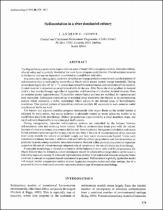JavaScript is disabled for your browser. Some features of this site may not work without it.
- ResearchSpace
- →
- Research Publications/Outputs
- →
- Journal Articles
- →
- View Item
| dc.contributor.author |
Cooper, JAG

|
|
| dc.date.accessioned | 2007-08-15T07:01:22Z | |
| dc.date.available | 2007-08-15T07:01:22Z | |
| dc.date.issued | 1993-10 | |
| dc.identifier.citation | Cooper, JAG. 1993. Sedimentation in a river dominated estuary. Sedimentology, Vol. 40(5), pp 979-1017 | en |
| dc.identifier.issn | 0037-0747 | |
| dc.identifier.uri | http://hdl.handle.net/10204/1108 | |
| dc.description | Copyright: 1993 Blackwell Publishing Ltd | en |
| dc.description.abstract | The Mgeni Estuary on the wave dominated cast coast of South Africa occupies a narrow, bedrock confined, alluvial valley and is partially blocked at the coast by an elongate sandy barrier. Fluvial sediment extends to the barrier and marine depositon is restricted to a small flood tidal delta. Sequential aerial photography, sediment sampling and topographical surveys reveal a cyclial pattern of sedimentation that is mediated by severe fluvial floods which exceed normal energy thresholds. During severe floods (up to 10 × 10[SUP3] m[SUP3] s[SUP-1]), lateral channel confinemtn promotes vertical erosion of bed material. Eroded material is deposited as an ephemeral delta in the sea. After floods the river gradient is retored within a few months through rapid fluvial depositon and formation of a shallow, braided channel. Over an extended period (approximately 70 years) the estuary banks and bars are stabilised by vegetation and mud deposition. Subsequent downcuttign in marginal areas transforms the channel to an anastomosing pattern which represents a stable morphology which adjusts to the normal range of hydrodynamic conditions. This cyclical pattern of deposition produces multiple fill sequences in such estuaries under conditions of stable sea level. The barrier and adjacent coastline prograde temporarily after major floods as the eroded barrier is reformed by wave action, but exces sediment is ultimately eroded sediment is ultimately eroded as waves adjust the barrier to an equilibrium plan form morphology. Deltaic progradation is prevented by a steep nearshore slope, and rapid sediment dispersal by wave action and shelf currents. During transgression, estuarine sedimentation patterns are controlled by the balance between sedimentaiton rates and receiving basin volume. | en |
| dc.language.iso | en | en |
| dc.publisher | Blackwell Publishing Ltd | en |
| dc.subject | Estuaries - South Africa | en |
| dc.subject | Sedimentation | en |
| dc.subject | Deposition | en |
| dc.title | Sedimentation in a river dominated estuary | en |
| dc.type | Article | en |
| dc.identifier.apacitation | Cooper, J. (1993). Sedimentation in a river dominated estuary. http://hdl.handle.net/10204/1108 | en_ZA |
| dc.identifier.chicagocitation | Cooper, JAG "Sedimentation in a river dominated estuary." (1993) http://hdl.handle.net/10204/1108 | en_ZA |
| dc.identifier.vancouvercitation | Cooper J. Sedimentation in a river dominated estuary. 1993; http://hdl.handle.net/10204/1108. | en_ZA |
| dc.identifier.ris | TY - Article AU - Cooper, JAG AB - The Mgeni Estuary on the wave dominated cast coast of South Africa occupies a narrow, bedrock confined, alluvial valley and is partially blocked at the coast by an elongate sandy barrier. Fluvial sediment extends to the barrier and marine depositon is restricted to a small flood tidal delta. Sequential aerial photography, sediment sampling and topographical surveys reveal a cyclial pattern of sedimentation that is mediated by severe fluvial floods which exceed normal energy thresholds. During severe floods (up to 10 × 10[SUP3] m[SUP3] s[SUP-1]), lateral channel confinemtn promotes vertical erosion of bed material. Eroded material is deposited as an ephemeral delta in the sea. After floods the river gradient is retored within a few months through rapid fluvial depositon and formation of a shallow, braided channel. Over an extended period (approximately 70 years) the estuary banks and bars are stabilised by vegetation and mud deposition. Subsequent downcuttign in marginal areas transforms the channel to an anastomosing pattern which represents a stable morphology which adjusts to the normal range of hydrodynamic conditions. This cyclical pattern of deposition produces multiple fill sequences in such estuaries under conditions of stable sea level. The barrier and adjacent coastline prograde temporarily after major floods as the eroded barrier is reformed by wave action, but exces sediment is ultimately eroded sediment is ultimately eroded as waves adjust the barrier to an equilibrium plan form morphology. Deltaic progradation is prevented by a steep nearshore slope, and rapid sediment dispersal by wave action and shelf currents. During transgression, estuarine sedimentation patterns are controlled by the balance between sedimentaiton rates and receiving basin volume. DA - 1993-10 DB - ResearchSpace DP - CSIR KW - Estuaries - South Africa KW - Sedimentation KW - Deposition LK - https://researchspace.csir.co.za PY - 1993 SM - 0037-0747 T1 - Sedimentation in a river dominated estuary TI - Sedimentation in a river dominated estuary UR - http://hdl.handle.net/10204/1108 ER - | en_ZA |






